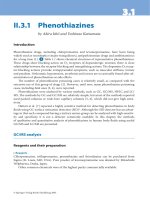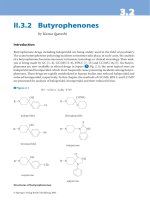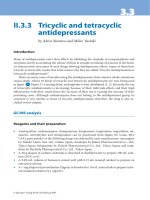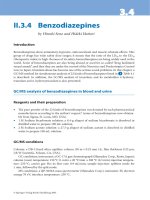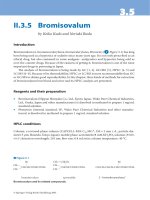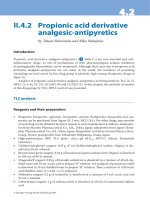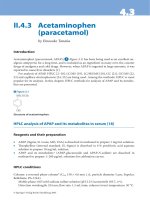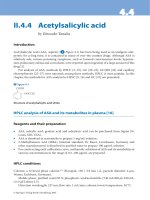Tài liệu Drugs and Poisons in Humans - A Handbook of Practical Analysis (Part 54) docx
Bạn đang xem bản rút gọn của tài liệu. Xem và tải ngay bản đầy đủ của tài liệu tại đây (385.44 KB, 7 trang )
6.4
6.4
© Springer-Verlag Berlin Heidelberg 2005
II.6.4 Methylxanthine
derivatives
by Osamu Suzuki
Introduction
Ca eine, theophylline and theobromine are contained in co ee, chocolate (cocoa) and tea
(black and green) as weakly basic natural alkaloids. e structures of the methylxanthine
derivatives/ xanthine derivatives including the above natural alkaloids together with synthetic
ones are shown in
> Table 4.1 [1]. eophylline, dyphylline ( diprophylline) and proxyphyl-
line are being used mainly as bronchodilators and/or heart stimulants.
Ca eine mildly stimulates the central nervous system (CNS), awakens people, relieves
them from general fatigue and activates mental activities. It has a relatively wide safe range of
doses and its estimated oral lethal dose is said to be about 10 g. erefore, it is di cult to be
poisoned by drinking co ee or tea. Ca eine becomes problematic, when it is mixed in large
amounts with an abused drug as an adulterant; in such cases, a large amount of ca eine can be
ingested into a human body. As a fatal action of ca eine, it acts on the heart provoking supra-
⊡ Table 4.1
Structures of methylxanthine derivatives
R
1
R
2
R
3
Misc.
492 Methylxanthine derivatives
ventricular tachycardia or supraventricular arrythmia and nally cardiac collapse to death;
especially for children, such poisoning can take place more easily [2].
eophylline is mainly used for treatment of bronchial asthma. Its characteristic is a nar-
row safe range of its doses. Its blood therapeutic concentrations are said to be 8–20 µg/mL; but
when the concentration exceeds 20 µg/mL, untoward e ects appear [2]. erefore, care should
be taken upon theophylline administration. In addition, many of the theophylline drugs are
being sold as extended-release capsules or tablets [3]. Since such forms of the drug exert its
e ect for long periods, its poisoning tends to become severe. As the most serious poisoning
symptom caused by theophylline, persistent convulsion due to stimulating CNS can be men-
tioned; such convulsion cannot be suppressed by any anticonvulsant. As other poisoning
symptoms, hypotension, vomiting, abdominal pain, diarrhea and bleeding from the digestive
tract may appear. It also causes arrythmias, such as atrial brillation, supraventricular arrth-
mia, supraventricular tachycardia and ventricular tachycardia, and occasionally causes cardiac
arrest [3].
For analysis of methylxanthine derivatives, GC [1, 4–7], GC/MS [8] and HPLC [9–12] were
used. In this chapter, a simple GC method for analyzing them [1] is described.
Reagents and preparation
i. Reagents and materials
e ten methylxanthine compounds listed in > Table 4.1 can be purchased from Sigma
(St. Louis, MO, USA); Sep-Pak C
18
cartridges (classic type) from Waters (Milford, MA, USA).
Other common chemicals used are of the highest purity commercially available.
ii. Preparation
• A 2-mg aliquot each (separately or altogether) of the methylxanthines is dissolved in 2 mL
methanol as the stock standard solution. Usually, a 10-µL volume of the solution is spiked
into 1 mL of blood plasma or urine (spiked concentration, 10 µg/mL). To get various
concentrations of the compound(s), the above stock standard solutions are diluted with
methanol appropriately.
• Chloroform/methanol (9:1), acetonitrile and distilled water: 100–200 mL each required.
• 0.1 M HCl: 1 mL of conc. HCl (12 M) is carefully mixed with 119 mL distilled water.
• 1 M KOH: 5.6 g of KOH is dissolved in distilled water to prepare 100 mL solution.
GC conditions
GC column
a
: a DB-17 fused silica capillary column (15 m × 0.32 mm i. d., lm thickness
0.25 µm, J&W Scienti c, Folsom, CA, USA).
GC conditions
b
: an HP5890 Series II gas chromatograph (Agilent Technologies, Palo Alto,
CA, USA); detector: FID; column (oven) temperature: 140 °C → 10 °C/min → 280 °C; injection
and detector temperature: 280 °C; carrier gas: He; its ow rate: 3 mL/min; injection: splitless
mode for 1 min followed by the split mode.
493Methylxanthine derivatives
Procedures
i. Urine specimen
i. A 5-mL volume of methanol and 5 mL distilled water are passed through a Sep-Pak C
18
cartridge to activate it.
ii. A 1-mL volume of a urine specimen, which may contain methylxanthine compound(s), is
mixed with an appropriate internal stadard (IS)
c
solution and 4 mL distilled water, and
poured into the activated cartridge with a 10-mL volume glass syringe.
iii. e cartridge is washed with 10 mL distilled water and the target compound(s) are slowly
eluted with 4 mL of chloroform/methanol (9:1); the eluate is collected in a 4-mL volume
glass vial.
iv. A er careful removal of the upper aqueous phase, the lower organic phase is evaporated to
dryness under a stream of nitrogen. e residue is dissolved in 100 µL methanol; 1 µL of it
is injected into GC
d
. e peak area ratio of a compound to IS is obtained.
v. For quantitation, a 1-mL volume each of blank urine obtained from a healthy subject, who
had not taken co ee or tea for not less than 1 day, is mixed with 10 µg IS and a di erent
amount (not less than 4 concentrations) of a target methylxanthine derivative, and treated
according to the above procedure to construct a calibration curve, consisting of peak area
ratio of a target compound to IS on the vertical axis and target compound concentration on
the horizontal axis. e peak area ratio obtained from a urine specimen is applied to the
calibration curve to calculate the concentration of a target compound.
ii. Plasma specimen
e
i. Blood is sampled from the median cubital vein into small test tube containing an antico-
agulant; a er mixing well, it is centrifuged at 3,000 rpm for 5 min to obtain blood plas-
ma.
ii. A 1-mL volume of plasma is mixed with IS
c
and 4 mL of 0.1 M HCl solution, vortex-mixed
and centrifuged at 3,000 rpm for 5 min. e resulting supernatant solution is transferred to
another bigger test tube. e sediment is again mixed with 4 mL of 0.1 M HCl solution,
vortex-mixed and centrifuged. e 2nd supernatant solution thus obtained is combined
with the previous one.
iii. Using a Pasteur pipette, an appropriate amount of 1 M KOH solution is dropped into the
above supernatant solution to adjust its pH to 6.5–7.5.
iv. e solution is poured into the activated Sep-Pak C
18
cartridge using a 10-mL volume sy-
ringe. e following procedure is the same as described in the steps iii–v for the urine
specimen. e calibration curve is constructed using blank plasma obtained from a healthy
subject, who had not taken co ee or tea for not less than 1 day in the same way.
Assessment and some comments on the method
> Figure 4.1 shows gas chromatograms with a DB-17 capillary column for extracts of plasma
and urine, into which 10 µg each of methylxanthines had been spiked, obtained by the present
method. Although some impurity peaks appeared around 200 °C in the chromatograms ob-
tained from blank specimens, the ten methylxanthines were separated well from each other
and from impurity peaks.
494 Methylxanthine derivatives
Gas chromatograms for the extracts of human plasma and urine in the presence and absence of
ten methylxanthines using a DB-17 medium-bore capillary column. 1: caffeine; 2: theobromine
3: 1,7-dimethylxanthine; 4: theophylline; 5: proxyphylline; 6: 3-isobutyl-1-methylxanthine;
7: pentifylline; 8: dyphylline; 9: pentoxyfylline; 10: 1,3,9-trimethylxanthine. A 10-µg aliquot each
of methylxanthines was spiked into 1 mL blood plasma or urine.
⊡ Figure 4.1
495
e recovery rates were not less than 75 % for all compounds. eir detection limits were
0.16–0.83 µg/mL.
Except the DB-17 column, a nonpolar DB-1 capillary column had been tested; however, the
tailing phenomenon was markedly observed for theophylline, theobromine, 1,7-dimethylxan-
thine and 3-isobutyl-1-methylxanthine. e DB-17 capillary column gave much better results
for this drug group.
> Figure 4.2 shows the metabolic pathways for ca eine. eophylline and 1,7-dimethyl-
xanthine are the metabolic intermediates of ca eine. When ca eine is taken, the above three
compounds can appear simultaneously. It should be noted that theobromine coexists with
ca eine in co ee and tea. When both theophylline and ca eine are detected simultaneously, it
is di cult to discriminate whether only ca eine or both are taken.
Poisoning cases, and toxic and fatal concentrations
Case 1 [13]: 1-year and 2-month-old female ingested 2 g ca eine. From 1 h a er ingestion,
repeated vomitings appeared; 10 h a er, general tonic and clonic convulsion was observed. She
was subjected to emergency admission to a hospital. Upon admission, her heart beat and res-
piration rates were 170 and 40/min, respectively. e blood ca eine concentration at 15 h a er
ingestion was 148 µg/mL. On the 2nd day of admission, adjustment of electrolytes was per-
formed, because hypopotassemia and hypochloremia appeared. On the 3rd day, the values of
CPK and serum myoglobin were 14,220 U/L and 405 ng/mL, respectively, suggesting rhabdo-
Metabolic pathways for caffeine in human bodies.
⊡ Figure 4.2
Poisoning cases, and toxic and fatal concentrations
496 Methylxanthine derivatives
myolysis. era er, her conditions were improved and she was discharged on the 10th day
without any neurological sequela.
Case 2 [14]: an 18-year-old female ingested 20–30 of extended-release tablets of theophyl-
line ( eodur
®
) at about 1:30 a.m. From about 3:00 a.m., vomiting was started; at 5:45 a.m.,
she visited an emergency room of a hospital and was admitted. Until 3:00 p.m., she su ered
from vomiting; in the vomitus, the debris of the tablets were included. At about 4:00 p.m., she
complained of a bad headache; her heart beat rate was 120/min, and blood theophylline con-
centration was 66.6 µg/mL. At 4:30 p.m., gastrolavage was performed by inserting a gastric
tube. en, 60 g of activated charcoal, 250 mL of magnesium citrate solution and 500 mL saline
solution were orally administered slowly. At the same time, an intravenous drip infusion of
2 ampoules of Primperan
®
(metoclopramide) and 25 mg of Wintermin
®
(chlorpromazine)
were made to prevent her from vomiting. erea er, she showed a trend of recovery; the blood
theophylline concentration in the next morning was as low as 6.1 µg/mL.
Blood therapeutic and toxic concentrations of ca eine are 8–15 µg and > 20 µg/mL,
respectively. Blood therapeutic theophylline concentrations are 8–18 µg/mL for adults and
5–10 µg/mL for small infants; blood toxic theophylline concentrations are 20–25 µg/mL for
adults and about 15 µg/mL for small infants [15]. It should be noted that the safe range of
doses for theophylline is very narrow.
Notes
a) Any capillary column with an intermediately polar 50 % phenylsilicone/50 % dimethylsili-
cone stationary phase can be used, regardless of its manufacturer.
b) Any type of GC instruments, to which a capillary column can be attached, is usable.
c) As IS, one of the methylxanthines except ca eine, theophylline, theobromine and 1,7-di-
methylxanthine listed in
> Table 4.1 can be chosen. A 10-µg aliquot of an IS is spiked into
1 mL of urine or plasma before the extraction procedure.
d) In place of GC, GC/MS can be used for analysis of methylxanthines with much higher
sensitivity and speci city, because all ten compounds dealt with in this chapter give intense
or base peaks of molecular ions in the positive EI mode [1].
e) Although blood plasma was used as a specimen in this chapter, whole blood seems usable
in place of plasma using exactly the same procedure.
References
1) Kumazawa T, Sato K, Seno H et al. (1994) Positive and negative ion mass spectrometry of ten xanthine derivatives
and their rapid clean-up with Sep-Pak C
18
cartridges from biological samples. Forensic Sci Int 68:53–67
2) Kuroiwa Y, Yoshida T (1997) Alkaloids. In: Brandenberger H, Maes RAA (eds) Analytical Toxicology for Clinical,
Forensic and Pharmaceutical Chemists. Walter de Gruyter, Berlin, pp 621–661
3) Naito H (2001) Poisoning of Industrial Products, Gases, Pesticides, Drugs, and Natural Toxins. Cases, Pathogenesis
and Its Treatment, 2nd edn. Nankodo Co., Ltd., Tokyo, pp 386–388 (in Japanese)
4) Bauza MT, Smith RV, Knutson DE (1984) Gas chromatographic determination of pentoxifylline and its major
metabolites in human breast milk. J Chromatogr 310:61–69
5) Verebey K, DePace A (1998) Rapid confirmation of enzyme-multiplied immunoassay test (EMIT) for phencycli-
dine-positive urine samples with capillary gas chromatography-nitrogen-phosphorus detection. J Chromatogr
427:151–156
497
6) Kapil R, Bruyere HJ Jr (1989) Application of capillary gas chromatography to study caffeine distribution in the
developing chicken egg. J Chromatogr 493:182–187
7) Kumazawa T, Seno H, Lee X-P et al. (1999) Extraction of methylxanthines from human body fluids by solid-
phase microextraction. Anal Chim Acta 387:53–60
8) Brooks KE, Smith NB (1991) Efficient extraction of basic, neutral and weakly acidic drugs from plasma for
analysis by gas chromatography-mass spectrometry. Clin Chem 37:1975–1978
9) Hartley R, Smith IJ, Cookman JR (1985) Improved high-performance liquid chromatographic method for the
simultaneous determination of caffeine and its N-demethylated metabolites in plasma using solid-phase
extraction. J Chromatogr 342:105–117
10) Setchell KDR, Welsh MB, Klooster MJ et al. (1987) Rapid high-performance liquid chromatography assay for
salivary and serum caffeine following an oral load. J Chromatogr 385:267–274
11) Rund-Christensen M, Aasen AJ, Rasmussen K et al. (1989) High-performance liquid chromatographic determi-
nation of (R)- and (S)-proxyphylline in human plasma. J Chromatogr 491:355–366
12) Mancinelli A, Pace S, Marzo A et al. (1992) Determination of pentoxifylline and its metabolites in human plasma
by high-performance liquid chromatography with solid-phase extraction. J Chromatogr 575:101–107
13) Yamazaki F, Mori H (eds) (2000) Guide to Acute Poisonings by Medical Drugs. Van Medical, Tokyo, p 76 (in Japa-
nese)
14) Yamazaki F, Mori H (eds) (2000) Guide to Acute Poisonings by Medical Drugs. Van Medical, Tokyo, p 149 (in
Japanese)
15) Uges DRA (1997) Blood level data. In: Brandenberger H, Maes RAA (eds) Analytical Toxicology for Clinical,
Forensic and Pharmaceutical Chemists. Walter de Gruyter, Berlin, pp 707–718
Poisoning cases, and toxic and fatal concentrations
